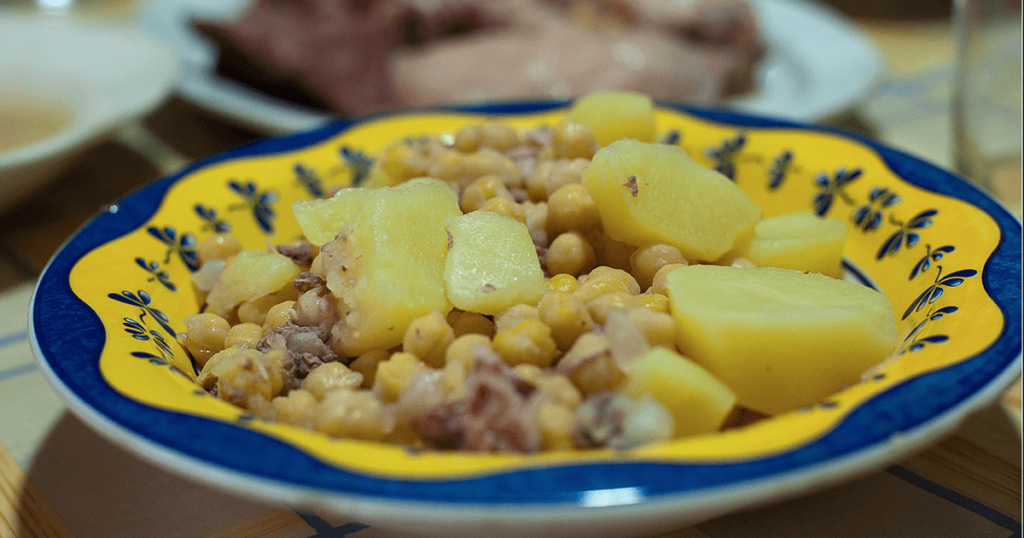
For many years, the dish cocido meant for me the Madrid version of garbanzos, cabbage, and sausage. It was delicious, and it never occurred to me to hope for anything more delicious. But a couple of years ago in the Maragatería region in the province of León, I had the local version, cocido maragato, and it’s even better. Instead of being served as one steaming bowl of stew, it comes as separate dishes—the broth, the garbanzos, the potatoes, the cabbage, and the smoked meats.
We were a group of 10 adults with six kids in tow, and we’d come over the mountains from Gijón for a day’s walk along the Camino de Santiago. Most of the group was dropped off at the beginning of the walk, and then the cars were driven ahead and left in the town at the end where in six hours we’d arrive, hungry and tired and ready to appreciate the meal in a restaurant there where we had reservations. One car returned with all the drivers, and it was left to be picked up on the way home at the end of the day. Off we started.
Along the way we met some other caminantes, walkers. The typical stage on the Camino is about 25 kilometers, 15 miles, and the usual routine is walk early, stop for a late lunch, and then walk on. But the retired couple we met were out not to do a stage a day but to have an adventure a day. They arose from their lodgings, had a cup of coffee, and set off, and when they got hungry, stopped for breakfast. They looked around, they detoured, they visited little villages off the established route, and they ate, and ate well. Eventually they would have lunch, and then a long siesta under a tree, before they looked for a place to relax for the night. They weren’t limited to a week of walking, or even two. They had the rest of their lives, they told us from the shade of a tree in a courtyard where they were resting when we came in, and there was no hurry. We, unlike the couple, did have a deadline: a three o’clock reservation. After a drink of water, we left them there, still drawing out their pleasure, and walked on, as the Spanish say, sin prisa pero sin pausa, without hurry but without halting. Eventually we arrived at the town and were ushered into the restaurant—one of a dozen along the old street, all refurbished low old houses, all serving the same specialty of cocido.
The local treat of migas, fried bread crumbs, came first; it was fantastic. The five dishes making up the cocido followed. Had they all been set down at once, I’d not have known where to begin, like the donkey in Buridan’s conundrum that can’t decide which equidistant pile of hay to sample first and so starves. My donkey, though, would never do that; he’d swing his big head in my direction, not rudely but as if to ask in mild perplexity, “Really? Two? What’s with that? Just give me one that lasts.” Then, finding himself closer to one pile, he’d start there.
Like my donkey, I was saved a decision. The dishes were brought one at a time, to be eaten in courses. I started. But first I contemplated. The dishes are served in the reverse of the usual order, the meat first, the broth last. I could have happily filled up on any one, but I knew another was coming, and proceeded cautiously. The meat was juicy, but I waited. Garbanzos, sweet. Potatoes, didn’t know they could be so satisfying. And then the shredded cabbage, a platter of it, a mound of red-gold, steaming, moist, succulent. Succulent but not wet! And the taste! I was in heaven, I was beside myself, I was, as the Spanish say, en mi salsa, in my sauce. If the wine comes early and is plentiful, you might also be cocido, literally meaning cooked but signifying sloshed, a danger when the wine is as rich and pleasing as the food on the table, the perfect accompaniment to first one dish, then another, then another.
That was in the village of Castrillo de los Polvazares one spring day, the afternoon advancing outside the windows of the small and cozy restaurant, time marked within by the cycle of dishes, the sense of well-being growing. The warm air, the hot food, the friends, the ray of sun through the small rippled panes of the old windows, the chilly morning behind and the chill evening still not upon us—why must it end? What’s with that?

